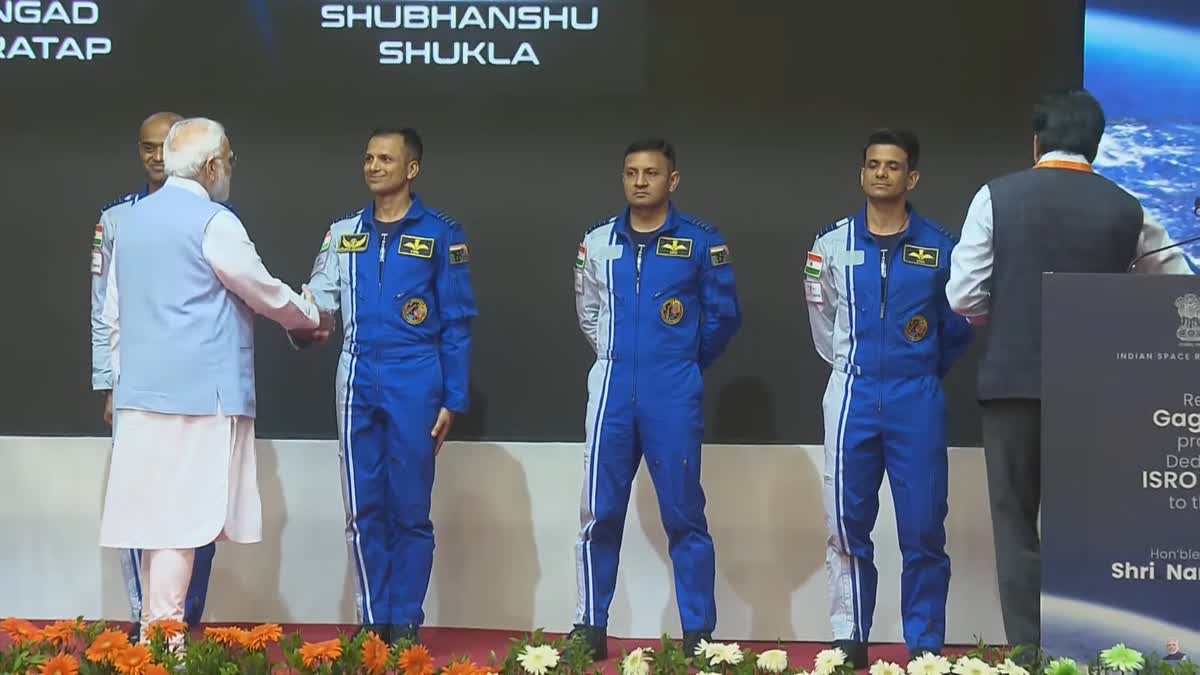Thiruvananthapuram (Kerala): Prime Minister Narendra Modi, Tuesday, handed over the 'Astronaut Wings' to four pilots chosen for the Gaganyaan mission, who made their first public appearance since the announcement of the project, at the Vikram Sarabhai Space Centre (VSSC) at Thumba near here.
A documentary showing the intense training the Gaganyaan has been undergoing and how they were practising 'Yoga', ahead of India's first human space flight program. With ISRO chief S Somanath passing on the 'Astronaut Wings', Modi presented it on Group Captain Prashanth Balakrishnan Nair, Group Captain Ajit Krishnan, Group Captain Angad Pratap and Wing Commander Shubanshu Shukla, who were present on the dais.
Kerala Governor Arif Mohammed Khan, Kerala Chief Minister Pinarayi Vijayan, Minister of State for External Affairs V Muraleedharan and ISRO chairman S Somanath were present on the occasion. This is the first time ISRO has showcased its astronauts to the world, and to its country, nursing the dreams of 140 crore population.
What Modi Said?
"Last year, India became the first country in the world to have unfurled its flag on the South Pole of the Moon. Today, 'Shiv Shakti Point' is introducing the whole world to the power of India. In the development journey of every country, there come some moments which not only define the present but also the future of its coming generations. Today is one such moment for India," Modi said, showcasing India's first-ever astronauts.
"Our present generation is very fortunate to have earned fame for historical works in 'Jal' (Water), 'Thal' (Land), 'Nabh' (Sky) and 'Antriksh'(Space). Today we all are witnessing a historic journey. Some time ago the country got acquainted with its four Gaganyaan passengers for the first time," he said.
"These are not just 4 names and 4 humans, these are 4 forces taking 140 crore aspirations into space. After 40 years, an Indian is going to go to space. But this time is also ours, the countdown is also ours and the rocket is also ours," he added.
"I urge the media persons and everyone else associated to be the supporting pillars and not hindrances for the 4 heroes who are set to go into Space. I urge you all not to distract them, and let them work with utmost focus and dedication. It's the beginning of the real story," Modi harped.
"Support them to the maximum possible extent. Holding the Tricolour in space and dreams of 140 crore population should be their only focus, and their only resolve," he appealed.
Modi also said that India's space sector's contributions were not only sowing the seeds of scientific temperament among the younger generations but also providing an impetus for the country to emerge as a global player in the 21st century.
He said that few nations have achieved the feats of reaching Mars in the first attempt, launching more than 100 satellites in a single mission, landing on the south pole of the Moon and successful insertion of the Aditya L1 solar probe in its orbit 15 lakh kilometers from Earth.
"All of you are opening new doors of future possibilities," he told the ISRO team, adding that it was estimated that India's space economy will grow five-fold and touch 44 billion dollars in the next 10 years.
The PM further said that India was becoming a global commercial hub in the field of space and in the coming days, it will once again go to the Moon, retrieve samples from there, and by 2035 the country will have its own space station.
"In this Amrit Kaal, an Indian astronaut will land on the Moon in an Indian rocket," he added.
In his speech on the occasion, the Prime Minister also stressed the "important role" played by women in the country's space programme. "Whether it is Chandrayaan or the Gaganyaan, no such project can be imagined without women scientists," he said and pointed out that over 500 women were in leadership positions in the ISRO.
He also recalled his statement about the beginning of a new 'kaal chakra' made during the Ram Temple consecration in Ayodhya and said that India was continuously expanding its space in the global order and its glimpses can be seen in the country's space program.
Three Space Projects Inaugurated
Prime Minister Modi also inaugurated three major space infrastructure projects of ISRO during his visit to the VSSC. The Prime Minister also reviewed ISRO's Gaganyaan human spaceflight programme. Modi also took a walkthrough of the exhibition of the various ISRO projects showcased at VSSC.
The projects inaugurated by Modi are-- a Trisonic Wind Tunnel at VSSC, a Semi-Cryogenic Integrated Engine and Stage Test Facility at ISRO's propulsion complex in Mahendragiri, Tamil Nadu, and the PSLV Integration Facility at the Satish Dhawan Space Centre in Andhra Pradesh's Sriharikota.
These three projects, which will provide world-class technical facilities for the space sector, have been developed at a cumulative cost of about Rs 1,800 crore. VSSC, the lead centre of the Indian Space Research Organisation, is responsible for the design and development of launch vehicle technology.
The Trisonic Wind Tunnel at VSSC produces controlled uniform airflow over scaled models of rockets and aircraft to evaluate their aerodynamic characteristics and designs. It features a test section size of 1.2 meters and can generate speeds ranging from subsonic to supersonic, up to 4 times the speed of sound (Mach number 4.0).
The Mahendragiri unit is a state-of-the-art facility capable of handling large flows of propellants. It stands 51 meters tall and has a flame deflector depth of 30 meters. The PSLV Integration Facilities at Sriharikota were developed to increase launch frequency from the First Launch Pad (FLP) and include the Integration Building, Service Building, Rail Track, and associated systems. The inauguration of these facilities marks significant advancements in India's space exploration capabilities. (With Agency inputs)
Read More



